Expert's Rating
Pros
- Impressive audio quality
- Excels as a digital photo frame
- Built-in Nest camera
- Google Assistant is one of the smartest assistants we’ve tried
Cons
- No physical camera shutter
- No analog audio output
- Google Assistant’s smart home compatibility still lags Alexa (though it’s catching up fast)
Our Verdict
With onboard Google Assistant, easy-on-the-eyes Ambient EQ display technology, a built-in Nest camera, and impressive sound, the $230 Google Nest Hub Max makes for one of the most compelling smart displays we’ve tested.
Price When Reviewed
This value will show the geolocated pricing text for product undefined
Best Pricing Today
Best Prices Today: Google Nest Hub Max
I was dubious about cramming a 10-inch smart display into the kitchen of my Brooklyn apartment, but now that it’s here, I don’t want the Google Nest Hub Max to leave. Boasting a slim and trim frame that belies it imposing-sounding name, the $230 Nest Hub Max makes for an able and willing sous chef, reading recipes and playing YouTube videos while also controlling smart home gadgets and monitoring your home. Stereo speakers deliver surprisingly robust sound, while its Ambient EQ display technology and agility at photo collages help to make the Nest Hub Max one of the best digital photo frames I’ve ever tried.
Still, the Nest Hub Max has its flaws, such as the lack of a physical camera shutter or analog audio jacks, while the competing Amazon Echo ShowRemove non-product link offers such compelling features as the ability to double as a Zigbee hub, not to mention Alexa’s superior level of smart device support compared to Google Assistant.
Design
While its “Max”-sized name portends a hulking gadget that’ll dominate any surface upon which it sits, the Google Nest Hub Max manages to look and feel surprisingly svelte given its 10-inch display. Measuring just four inches deep, the Nest Hub Max is essentially just a tablet that’s being propped up by the rounded, fabric-covered base. The overall result is a smart display that feels airy and stylish rather than bulky and monolithic.
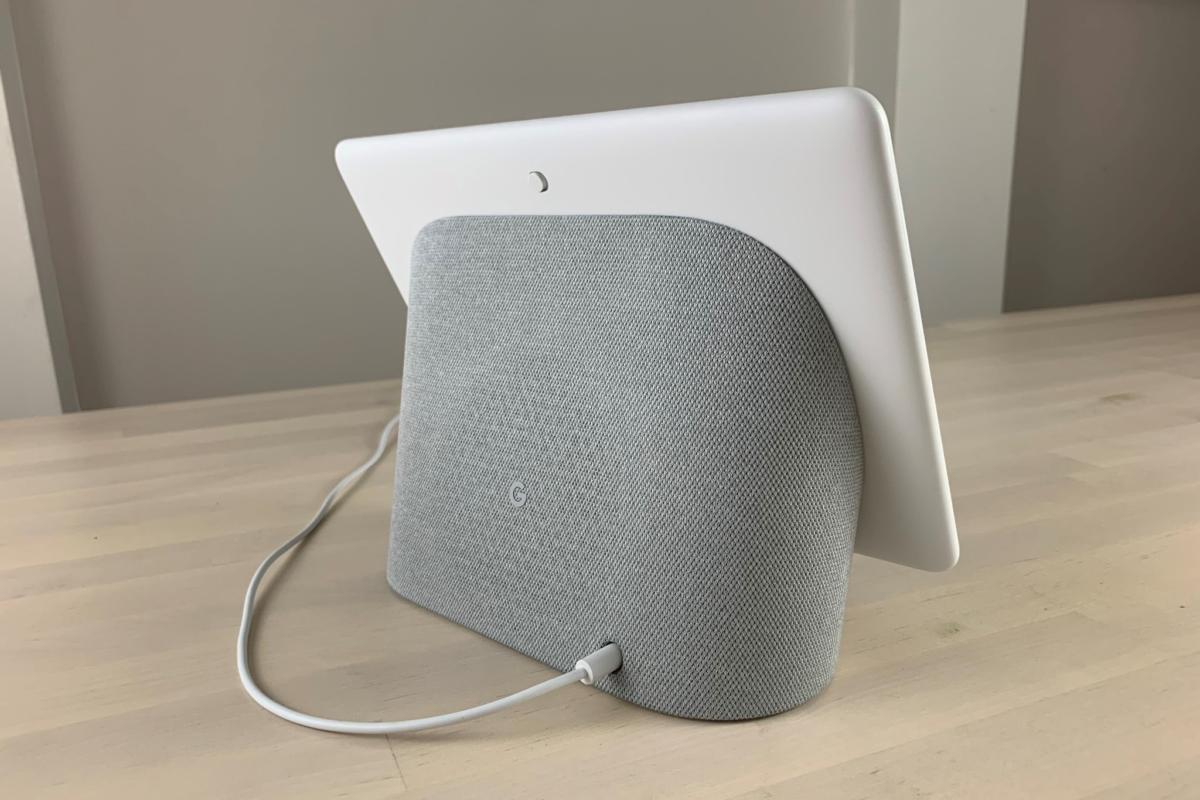 Ben Patterson/IDG
Ben Patterson/IDG
The Google Nest Hub Max boasts a surprisingly slim profile given its 10-inch display.
The 1280 x 800 display looks reasonably bright and sharp, perfectly fine for watching YouTube videos or for use as a digital photo frame. What’s more impressive than the screen itself, however, is its Ambient EQ technology.
Using a light sensor in the top bezel of the screen, Ambient EQ scans the ambient light and does its best to match the light and colors in the room. With Ambient EQ enabled, the Nest Hub Max’s display blends nicely into its surroundings, with (for example) your family photos looking as though they’re physical photos rather than glaringly bright images on an LCD screen. It’s a pleasing touch (to my eyes, anyway) that keeps the Nest Hub Max from sticking out like a sore thumb.
The display can also (like plenty of other smart displays, including Amazon’s Echo Show line) automatically switch itself into night mode when you turn off your room lights.
Besides the ambient light detector, the top bezel of the display houses the (aforementioned) 5.6MP camera, which doubles as a Nest security camera (more on that in a bit), while both the light sensor and the camera are flanked by a pair of far-field microphones. If you want some privacy, a switch near the top of the display’s back panel can electronically disable the microphones and the camera lens, although there’s no physical lens cover. (The competing 10-inch Amazon Echo Show also lacks an actual camera shutter.) A green indicator light next to the lens flashes when the camera is in use.
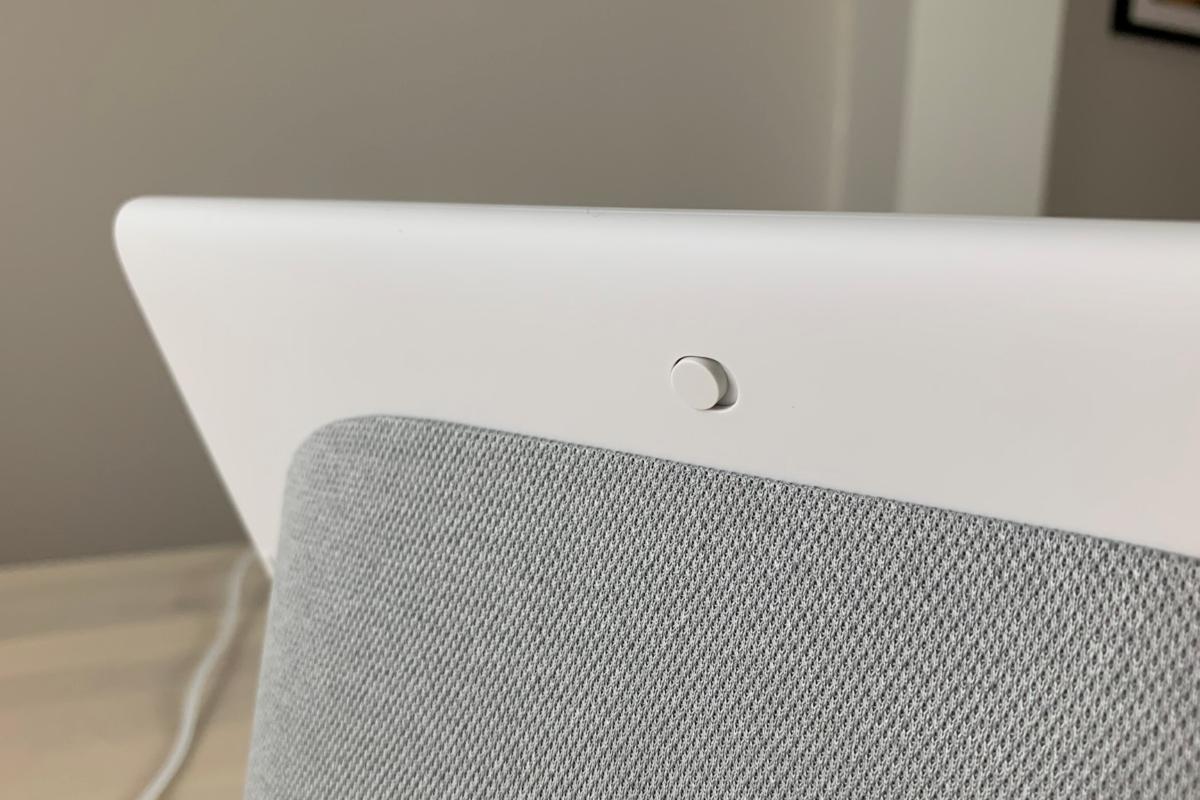 Ben Patterson/IDG
Ben Patterson/IDG
The Google Nest Hub Max’s privacy switch disables its camera and mutes the mic, but there’s no physical camera shutter.
On the rear of the Nest Hub Max’s base is a barrel-shaped power port for the included 30-watt power adapter. There’s no 3.5mm audio jack for attaching a speaker, but you can always pair a Bluetooth speaker to the display, and besides, the Nest Hub Max’s stereo speakers are nothing to sneeze at. Built into the base are a pair of 18mm tweeters and a 75mm woofer, and while the Nest Hub Max’s reasonable detailed and impressively loud sound won’t rival that of a pricey Sonos One speaker, it still manages to pack a punch, and I thoroughly enjoyed it while I was cooking in the kitchen.
Setup
Getting the Google Nest Hub Max up and running takes a variety of steps, but none of them are terribly tricky, and the display does a good job of guiding you through the process. The first step is to download the Google Home mobile app (assuming it’s not already on your phone) and directing it to discover the Nest Hub Max. Once connected, you can use the app to connect the Hub Max to your Wi-Fi network, as well as activate features ranging from Face Match (which uses the camera to identify you and boost the relevance of Google Assistant’s responses) to linking music services (including YouTube Music, Pandora, and Spotify). and picking what you want the screen to do when it’s in Ambient (or essentially idle) mode.
A significant portion of the Nest Hub Max setup process is devoted to privacy, with the device letting you know exactly what information it’s collecting, what data it might be providing to third parties, and why its camera and microphones might be recording you, all the while offering you the chance to opt out of this service or that one. Yes, it’s a tedious process, but also necessary given the privacy scandal that rocked the digital assistant industry this past summer.
On a more positive note, it’s worth calling out one of the options you get for the display’s Ambient mode: displaying a slideshow of your family photos. No, there’s nothing revolutionary about a smart display doubling as a digital photo frame (the Amazon Echo Show and Echo Spot devices do it too), but Google Photos does a particularly great job with its Live Albums feature, which lets you pick and choose which of your friends and loved ones you’d like to see included. It then keeps the album updated with any new photos you add.
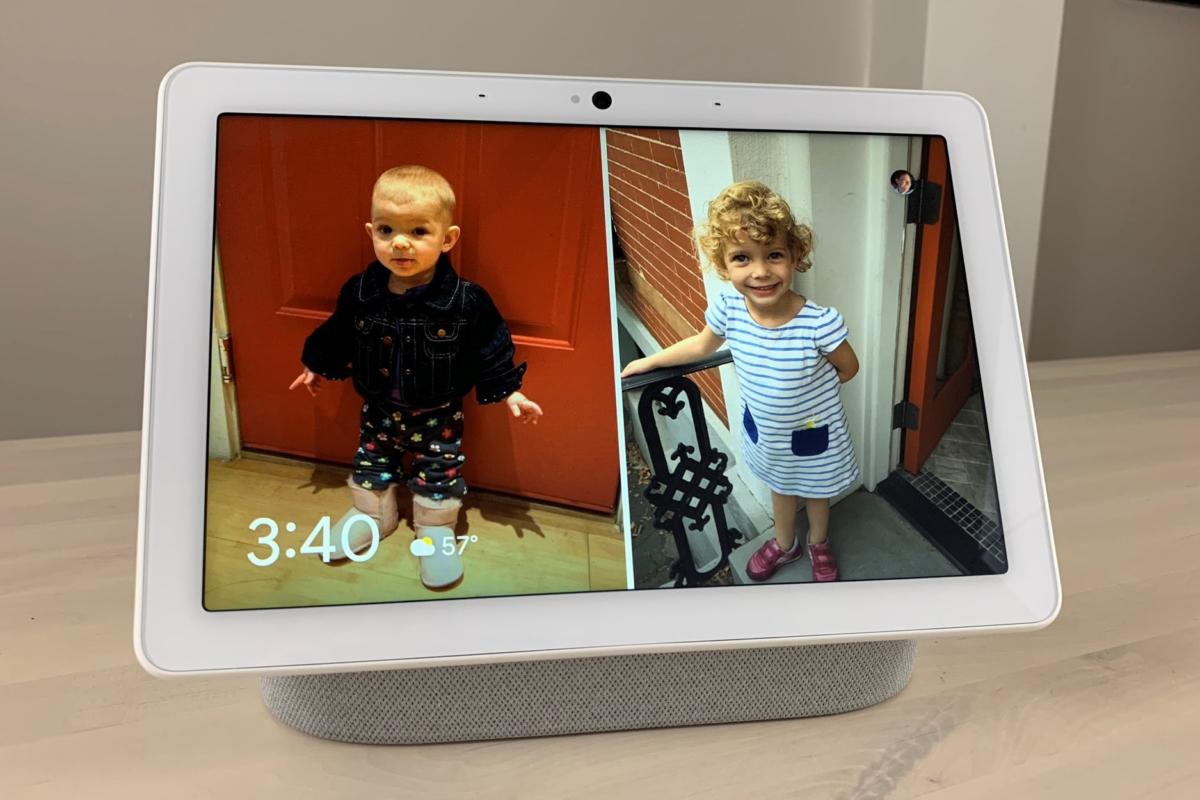 Ben Patterson/IDG
Ben Patterson/IDG
With its Ambient EQ display technology and skill at creating photo collages, the Nest Hub Max excels as a digital photo frame.
The Google Home app prompted me to do all this during the Nest Hub Max setup process, and soon I was looking at a skillfully curated and arranged photos and collages of my family, close relatives, and friends. There’s no such Live Albums feature over at Amazon Photos, and my (smaller) Echo Show 5 never bothers to arranges portraits in an attractive collage.
Google Assistant
Once the setup process is completed, you can begin chatting with Google Assistant. If you chose to enable Face Match (the Google Home mobile app steps you through a brief process of scanning your face) and Voice Match, the Nest Hub Max’s display should recognize you, allowing Google Assistant to, for example, read and display your schedule or tee up YouTube videos that it thinks you’ll like. Once my wife scanned her face with Face Match, she was able to ask Google Assistant for her schedule and personalized recommendations, too.
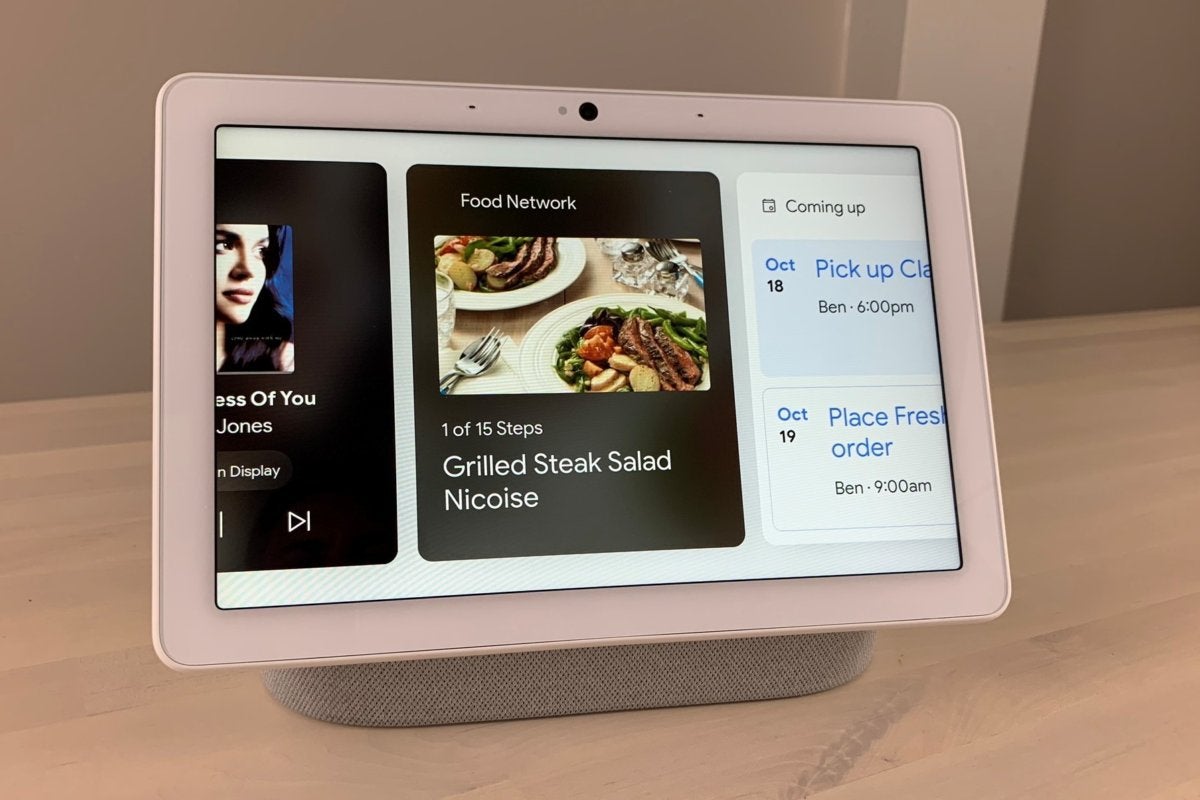 Ben Patterson/IDG
Ben Patterson/IDG
Once it recognizes you via its Face Match feature, the Nest Hub Max will give you personalized content and recommendations.
Besides its standard abilities to give you a weather forecast or describing the various snarls that await you during your morning commute, Google Assistant consistently surprised me with such thoughtful and intelligent touches as gorgeously laid-out search-result pages when I asked about dinosaurs, or by telling me that Norah Jones will be performing nearby in a few days when I asked to hear some of her songs on Spotify. And the first time it sees me in the kitchen each morning, Assistant gives me a daily briefing, complete with the weather, my appointments, news (tailored to my interests, of course), and other tidbits.
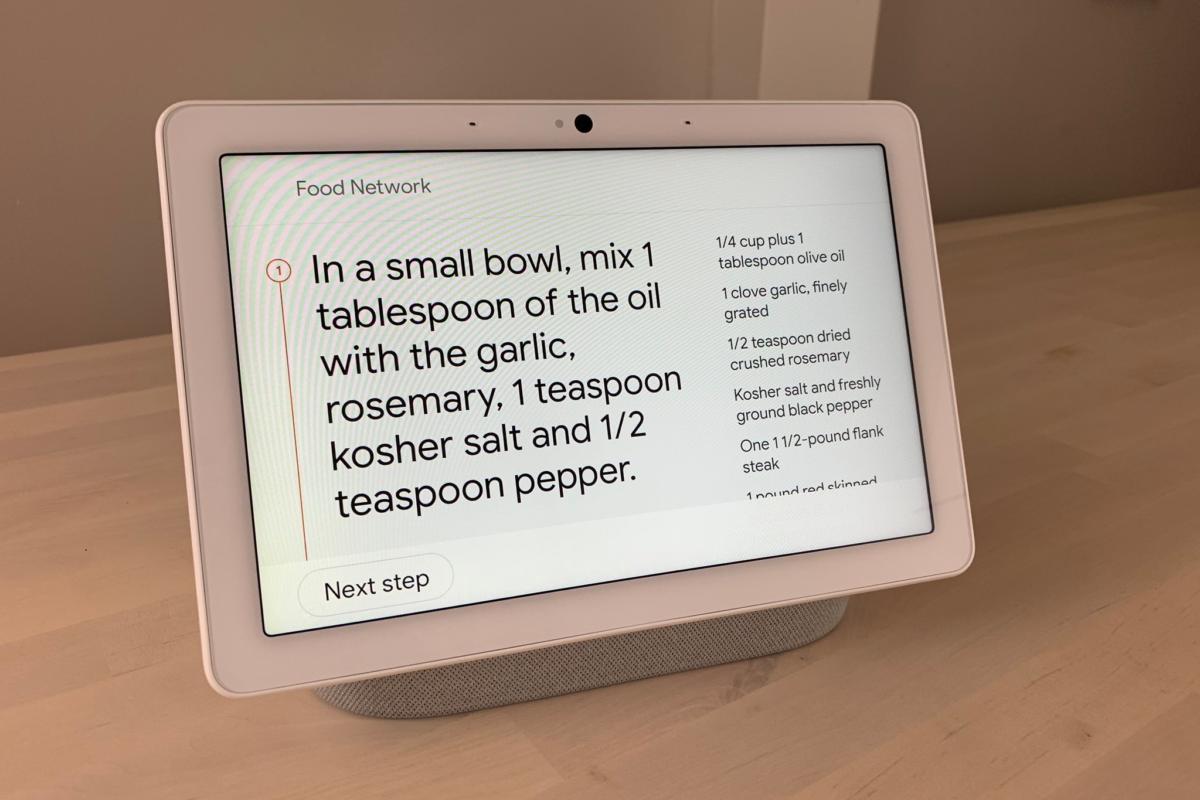 Ben Patterson/IDG
Ben Patterson/IDG
The Google Nest Hub Max does a particularly good job at both displaying and reading aloud recipies from the web.
If you’re using the Nest Hub Max in the kitchen (as I did), Google Assistant can look up recipes on the web, read out the ingredients one by one, and then step you through the instructions, complete with a polished written-out version on the screen in type that’s big enough to read from behind the kitchen counter.
Smart home and Nest capabilities
While Google Assistant lacks the broad support that Alexa enjoys when it comes to smart home devices, it is gaining ground, with Google claiming that more than 30 thousand smart gadgets now offer Google Assistant support. Given that Google owns Nest, it shouldn’t come as a surprise that Google Assistant boasts tight integration with such Nest devices as cameras, doorbells, lights, and thermostats.
Speaking of Nest, the Nest Hub Max’s built-in camera doubles as a Nest security cam, allowing you to peek inside your home while you’re out. Boasting a 127-degree field of view, the Nest camera can transmit both audio and video to the Google Home app, and if you sign up for a Nest Aware subscription plan (starting a $5 at month for each camera, or $6/month and up for all your Nest devices starting in early 2020), it can keep a five- to 30-day video history as well as send you mobile alerts if it spots someone it doesn’t recognize. That’s a nifty bonus for anyone who’s already monitoring their home with smart security devices, and for apartment dwellers like me who have yet to invest in home security, it’s like getting an instant, zero-effort home monitoring kit.
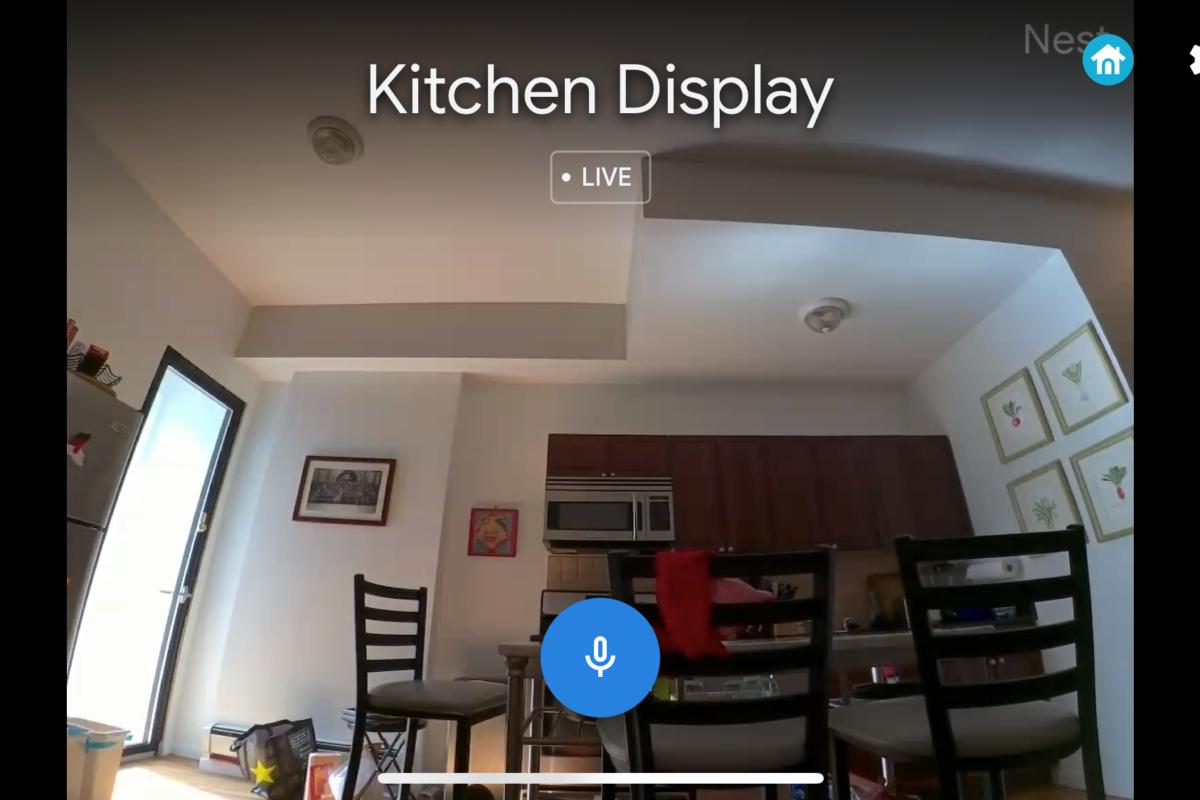 Ben Patterson/IDG
Ben Patterson/IDG
The Google Nest Hub Max’s built-in camera doubles as a Nest camera, allowing you to check up on your home while you’re away.
All well and good, but it’s worth noting that Amazon’s 10-inch Echo Show boasts its free Alexa Guard feature, which keeps an ear out for breaking glass, alarms, and other suspicious sounds. (Nest Aware will offer a similar feature starting next year, but you’ll need to pay for it.)
The biggest Echo Show also throws in an enticing smart home feature that the Nest Hub Max lacks: the ability to double as a Zigbee hub, perfect for connecting Zigbee-compatible smart lights and other devices to your network without the need for a separate bridge.
Finally, while the Nest Hub Max packs in tight Nest integration, the Echo Show ties in with Amazon’s line of inexpensive Ring home security products, including the excellent Ring Alarm.
UI and gestures
You can swipe down from the top of the screen to see a room-by-room overview of all your various connected smart gadgets, and you can tap (for example) a light to turn it on or adjust its brightness, or crank the volume on your network-connected A/V receiver.
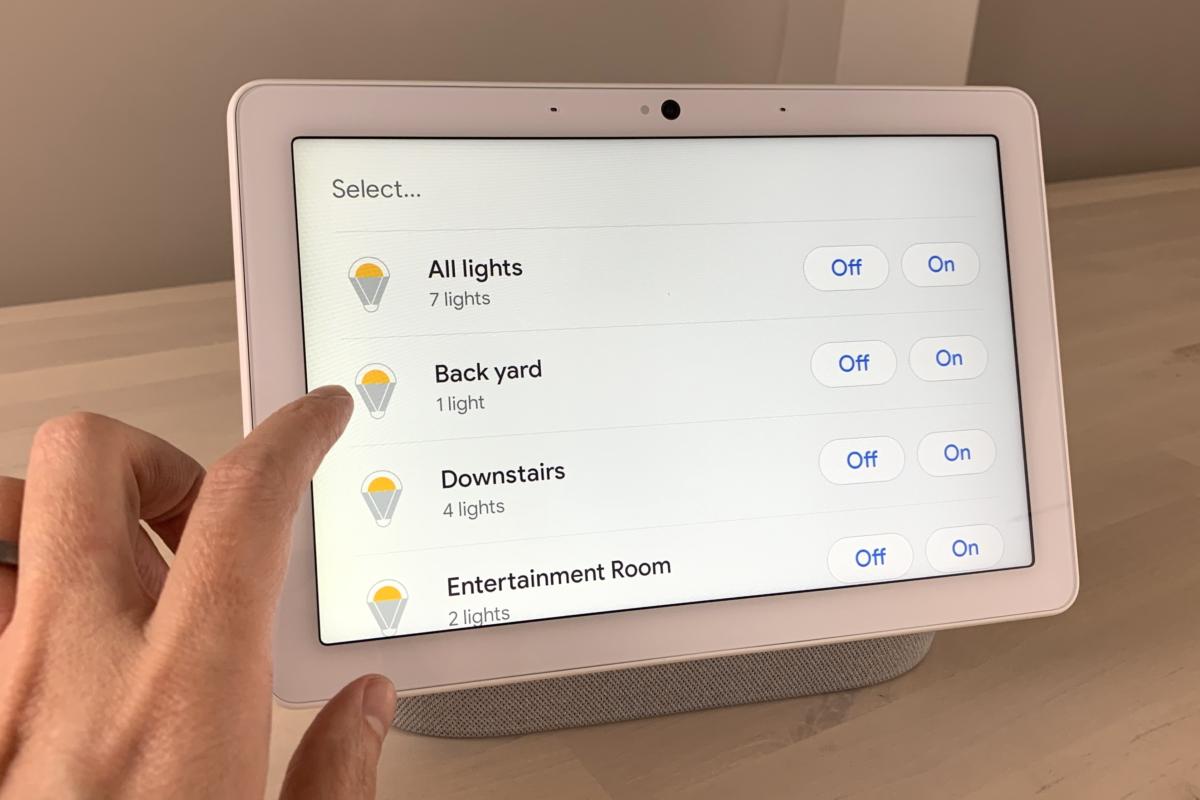 Ben Patterson/IDG
Ben Patterson/IDG
Just swipe down from the top of the Google Nest Hub Max’s display for an overview of your connected smart home devices.
Swiping up from the bottom of the display lets you access such basic settings as screen brightness and volume, disable the camera, and toggle the “do not disturb” mode. Swipe left from the right side of the screen and you’ll see a series of cards that Google Assistant picked for you, from news headlines and YouTube recommendations to Spotify playlists and nearby events.
Thanks to the camera, the Nest Hub Max also supports Quick Gestures, which (for now) are limited to looking at the screen and holding up your palm to pause your tunes, or raising your palm again to restart the music.
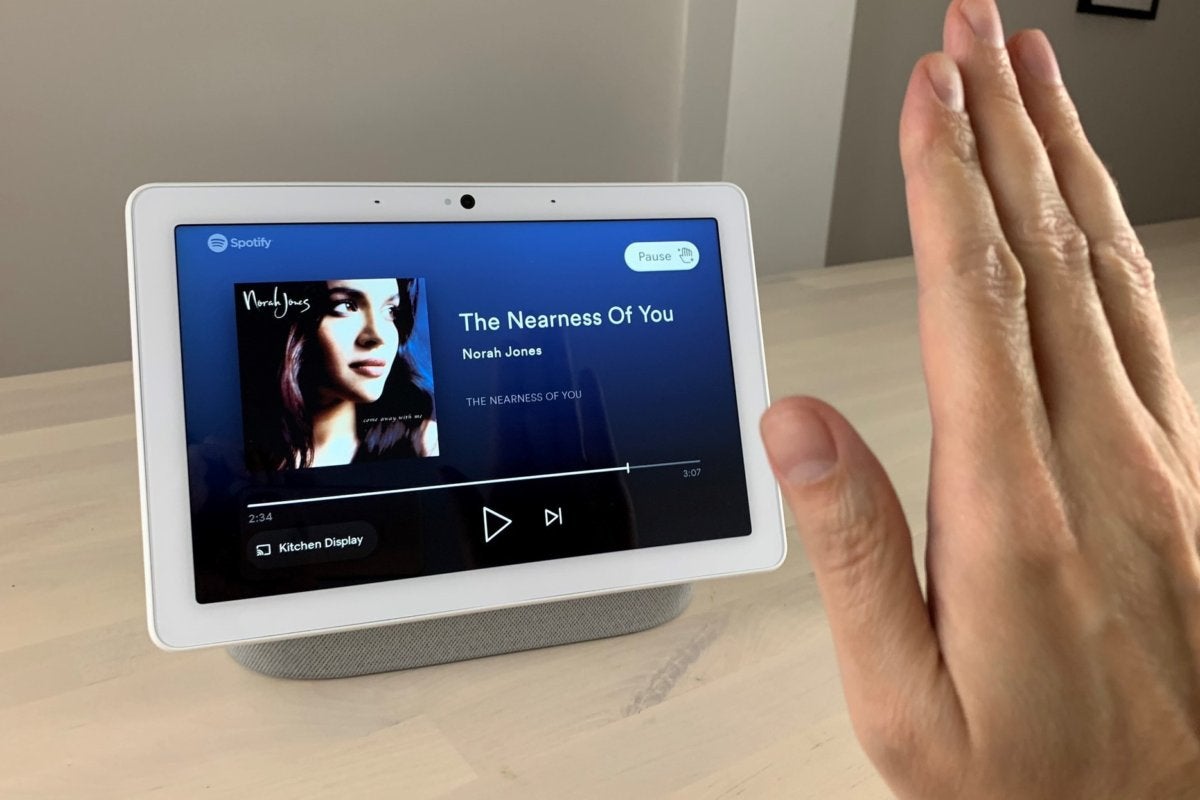 Ben Patterson/IDG
Ben Patterson/IDG
You can pause your music without saying a word by simply looking at the screen and holding up your palm.
Communication and Chromecast
Thanks to its support for Google Duo video calls, the Nest Hub Max excels as a way to keep in touch with friends and family, with the camera lens capable of following you around the room. You can also place audio calls to any Home Mini or Nest Mini speakers in your house (“Hey Google, call the living-room speaker”), or broadcast an announcement to all your Google speakers (“Time for dinner!”).
When you’re not summoning family members to the dinner table, you can watch videos from any Chromecast-enabled app. While I was getting lunch ready on a recent Sunday, for example, I cast the Oakland Raiders/Green Bay Packers game to the Nest Hub Max via the NFL Sunday Ticket app. While Amazon’s Echo Show devices do offer Alexa skills for various cable, TV, and audio services (including NBC, CNBC, NPR, and SiriusXM), the Nest Hub Max’s Chromecast capabilities offer far more flexibility in terms of what I can watch or hear on the display. And of course, you can also turn the Nest Hub Max into a full-on TV if you spring for a $50-per-month YouTube TV subscription. (The Echo Show, for its part, offers live TV via Hulu for $45 per month.)
Google Nest Hub Max or Amazon Echo Show?
If your life revolves around Gmail, Google Calendar, and other Google services, you’ll love Google Assistant’s ability to tee up the day and dole out relevant content, while Nest users will appreciate controlling their devices and monitoring their homes via Assistant and the Nest Hub Max’s jumbo display. That said, smart home mavens might be better off sticking with Alexa, given her near-ubiquitous smart device support—not to mention the thousands of skills at her beck and call.
As for the Nest Hub Max and 10-inch Echo Show devices themselves, there’s no clear winner. Both have relatively compact designs, both have stereo speakers with woofers, neither has a 3.5mm audio jack (although the Echo Show does have a micro-USB port that allows for wired ethernet connections via an adapter), and both have cameras for video chat. Yes, the Nest Hub Max’s camera doubles as a Nest camera; then again, the Echo Show doubles as a Zigbee hub.
In short, this is a tough call, and as we often say when it comes to choosing between a Google Nest Home or Amazon Echo device, your decision will probably come down to the smart assistant to which you’re most loyal.
Bottom line
With onboard Google Assistant, easy-on-the-eyes Ambient EQ display technology, a built-in Nest camera, and impressive sound, the $230 Google Nest Hub Max makes for one of the most compelling smart displays we’ve tested. If you’re looking for a helpful, hands-free digital assistant in your kitchen that doubles as a TV and even keeps an eye on your home while you’re away, the Nest Hub Max is tough to beat. That said, the equally compelling 10-inch Amazon Echo Show will surely tempt Alexa aficionados, particularly those committed to third-party smart home gadgets outside of Google’s Nest ecosystem.

